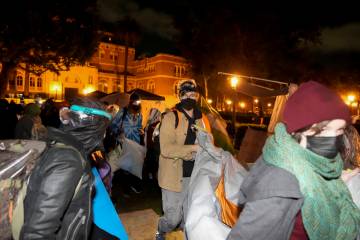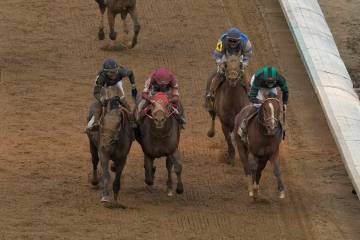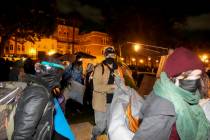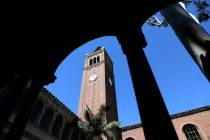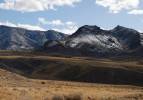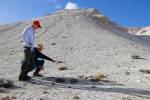Clock ticking for California governor’s big water project
CLARKSBURG, Calif. — Atop a dirt levee his great-grandfather built in the 1800s to hold back California’s mightiest river, Northern California farmer Russell van Loben Sels looks out over the site of a new water project, one that would be the state’s most ambitious in a half-century.
Promoted by Gov. Jerry Brown, the $15.7 billion project would run giant twin pipes, each four stories high, underground for 35 miles and eventually pull thousands of gallons of water a second from the stretch along the Sacramento River where van Loben Sels farms to cities and farms to the south.
In what all agree will be the decisive year for the project, Brown’s plan — which is facing obstacles to environmental approval in the Sacramento-San Joaquin River Delta and mounting uncertainty over the financing — is splitting farmers and political leaders.
In the delta, a land of tree-lined river banks, pear orchards and Gold Rush-era Victorian homes, signs saying, “Stop the Tunnels,” hang on farm gates and shop walls. People fear the tunnels would let the state take too much water from the delta.
“I do resent the fact they look at the delta as being sort of expendable to protect their farms,” van Loben Sels said, driving a narrow river road that would be replaced by widened highways and massive water intakes. “It’s just the destruction of the delta.”
In the arid part of California that encompasses Los Angeles and the country’s most productive agricultural region, the San Joaquin Valley, farmers and water managers facing drought, climate change and growth see water becoming scarcer. They hope the tunnels can bring them more.
“We’re barely trying to hold our own,” said Michael Stearns, walking the bare dirt of 2,700 acres, almost half of the nearly 10-square mile farm he has fallowed owing to water cuts amid the driest four-year stretch in California’s history.
Much of the idle land where tomatoes and cotton normally grow is equipped with water-efficient drip irrigation. Stearns, the general manager of the farm, said he may next have to take out the farm’s main money-makers — wine grapes and pistachios.
“That’s why the security of the water is just so critical,” he said.
Questions over the environmental impact and financing are driving the debate on the tunnels — a construction feat that would rival or dwarf most tunnel projects of recent decades, including the tunnel beneath the English Channel and Boston’s Big Dig.
“Nobody’s told me they’re ready to write me a check to build their share of the project,” said Mark Cowin, director of the state Department of Water Resources. “A lot of it comes down to trust on both sides of the table.”
A labyrinth of waterways, fields and islands, the delta stretches inland 75 miles from San Francisco Bay at the confluence of big rivers that start high in Northern California mountains. It is the heart of the state’s water system, feeding two-thirds of the state’s residents, 3 million acres of farmland, and wildlife.
In the 1960s, under then-Gov. Pat Brown — the current governor’s father — California and the federal government re-engineered the delta to pump water from the southern end to farms and communities as distant as San Diego.
But the pumps altered the delta’s flow, pulling migrating fish off course. Once-bountiful stocks of Delta smelt, Chinook salmon and other native species have plummeted. At least 35 native fish, plants and animal species there are now listed under federal and state endangered-species acts.
This year and last, authorities cut water deliveries from the delta to save enough for endangered fish. The cuts angered farmers and others, yet still failed to keep water plentiful and cool enough for the fish, causing record declines.
Brown’s plan adds water intakes and tunnels just north of the delta, away from the smelt habitat. And officials say the project would almost halve the time that the damaging pumps in the southern delta would run.
The delta re-do would come at a steep price. And in interviews, just one of the five key water agencies potentially footing the cost expressed readiness to pay its share.
For the urban Metropolitan Water District of Southern California, a long-term, more reliable water source for its 19 million customers would make the investment worthwhile, if other water districts go along, general manager Jeffrey Kightlinger said.
“I think it’s time to essentially call the question — are we going to do this or not?” he said.
Districts serving mainly farmers, however, expressed skepticism the tunnels make sense financially.
“We want the project to work,” said Johnny Amaral, deputy general manager of San Joaquin Valley’s Westlands Water District, the nation’s largest irrigation district and a major player behind the tunnels. “But in order for us to continue, it has to result in more water and reliability.”
Jason Peltier, head of the San Luis & Delta-Mendota Water Authority, said, “Nobody is willing to declare it a dead project,” given the broad desire for something that improves the current system.
Questions over funding deepened this month when federal regulators levied a rare fine in a settlement with Westlands. The Securities and Exchange Commission said the water district had misled bond investors about the toll drought and water cuts were taking on its revenues.
One major bond-ratings agency said it may lower Westlands’ creditworthiness, which could make it more expensive to borrow money for the tunnels. Amaral said it was too early to know how the settlement would affect tunnel financing.
Under current plans, the tunnels will bring only a “marginal” boost in water — another 65 billion gallons a year on average — to be sent south from the delta, said Cowin of the state water agency.
That’s enough for 200,000 households, out of California’s 39 million residents. The project draft also allows water districts to ask for easing of some environmental limits on pumping in dry years, which worries environmentalists.
Tunnels opponents say the government and water agencies should put more money in water conservation and recycling projects instead.
The benefit of the tunnels, backers say, is that they will be more reliable than the current system in weathering earthquakes and climate change.
Brown denies the criticism that he is pursuing the tunnels as a legacy project in his final two years as governor.
“It has nothing to do with that,” he told reporters in January. “It’s absolutely necessary for California’s future.”
Things to know about California’s giant twin tunnels project
California is proposing its most ambitious water project in a half-century. At $15.7 billion, it would run two giant tunnels, each four stories high, for 35 miles under the Sacramento-San Joaquin River Delta in Northern California, sending water to cities and farms to the south. In size and cost, the feat would rival or dwarf the tunnel under the English Channel and Boston’s Big Dig.
WHY IT’S PROPOSED
The way water is taken today from the delta has altered natural flows, making it run backward in parts and pulling migrating native fish off course. Once-bountiful stocks of Delta smelt, Chinook salmon and other native species have plummeted. At least 35 native fish, plants and animal species there are now listed under federal and state endangered-species acts. Environmental regulations limit how much water can be pumped from the delta.
BACKERS
Gov. Jerry Brown is promoting the project that would be paid for by cities and farmers mainly in dry parts of California, including Los Angeles, the country’s second-most populous city, and the most productive agricultural region, the San Joaquin Valley. These farmers and water managers who face drought and climate change hope the tunnels will bring them a more reliable water supply.
OPPONENTS
Residents and farmers who have tilled the delta soil for generations fear the tunnels would let the state take too much water from the delta, changing life forever in the bucolic landscape of pear orchards and Gold Rush-era Victorian homes. Construction could run through 2029, with trucks moving more than 30 million cubic yards of earth.
OBSTACLES
In a decisive year for the project, the state must win approval from federal and state wildlife agencies. Given environmental and water-rights laws limiting how much water can be taken from the delta, agencies expected to foot the bill are asking if they will receive enough water to make the steep price worthwhile.










